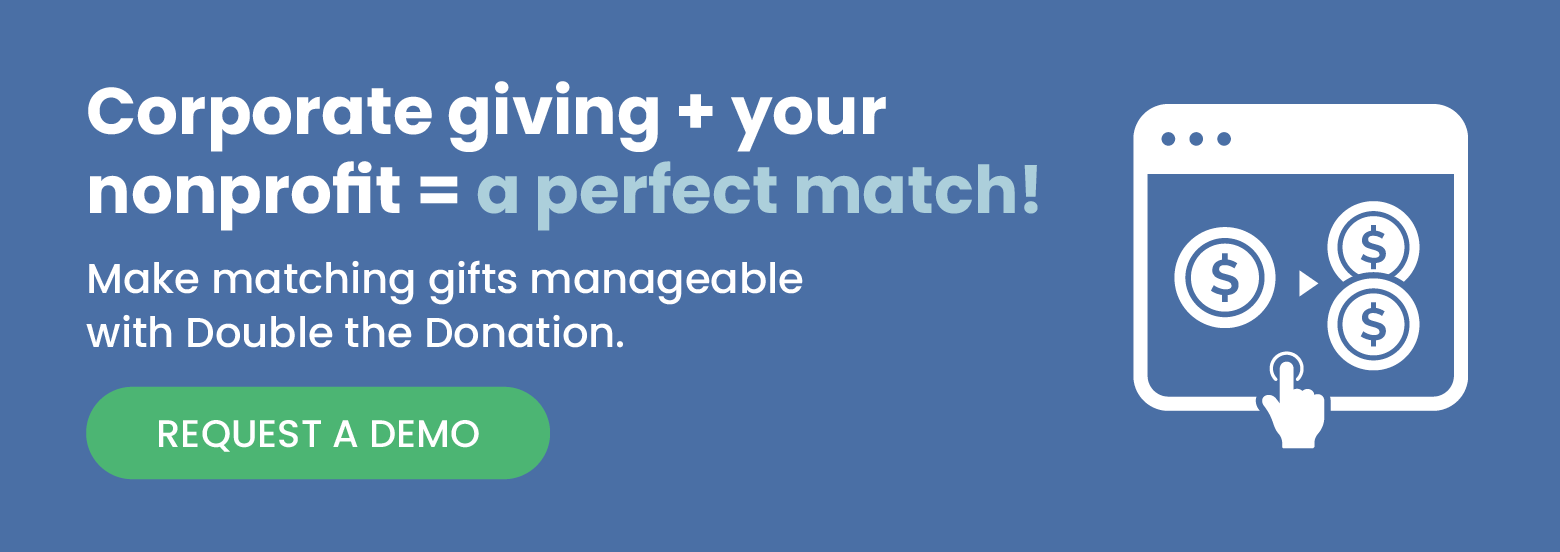Corporate Grants for Nonprofits: Tips for Raising More
Corporate grants for nonprofits can be a game-changer for organizations looking to expand their impact. With businesses increasingly focused on corporate social responsibility (or CSR), many are eager to fund initiatives that align with their mission and values. However, the competition for these grants is fierce, and navigating the application process requires strategy, relationship-building, and a compelling case for support.
That’s why, in this guide, we’ll explore key tips to help your nonprofit stand out and raise more through corporate grants. Specifically, we’ll cover:
- Researching Corporate Grant Opportunities
- Building Relationships with Corporations
- Crafting a Strong Corporate Grant Proposal
- Reaching Out to Make Your Pitch
- Following Up & Maintaining Long-Term Relationships
Ready to begin securing additional support for your cause through corporate grants and beyond? Let’s get started with our top grant-seeking tips for nonprofits like yours.
Researching Corporate Grant Opportunities
Before applying for corporate grants, nonprofits must invest time in thorough research to identify the best opportunities. After all, not all corporate grants are the same—each company has specific funding priorities, eligibility criteria, and application processes.
Here’s how to effectively research and target corporate grant opportunities that align with your nonprofit’s mission:
1. Identify Companies with a Strong CSR Focus
Start by looking for corporations that have a history of giving to causes similar to yours. Many companies outline their Corporate Social Responsibility initiatives on their websites, detailing the issues they support and the types of organizations they fund. You can also look for already-compiled lists of the top corporate grants available to get started.
Pay attention to businesses that operate within your geographic region or industry, as they may prioritize local or mission-aligned initiatives.
2. Use Grant Databases and Online Resources
Several online tools can help streamline your search for corporate grants. Platforms like Double the Donation, Candid’s Foundation Directory, GrantWatch, and Instrumentl all provide searchable databases of available grants and other giving programs.
Additionally, many large corporations have dedicated philanthropy pages where they list open grant opportunities, past recipients, funding requirements, and more.
3. Research Past Grant Recipients
Understanding which nonprofits have previously received funding from a corporate grant can give you valuable insights into what the company looks for in a successful applicant. Check the company’s annual CSR reports, press releases, or nonprofit websites to find this information.
If possible, you might even reach out to past recipients to gain firsthand knowledge of the grant application and funding process.
4. Align Your Mission with Corporate Priorities
Corporate grants are often awarded based on alignment with the company’s values and community engagement goals. When researching grant opportunities, look for corporations that focus on areas directly related to your nonprofit’s mission.
For example, an environmental nonprofit might target grants from companies with sustainability initiatives, while an education nonprofit could look for corporate funders investing in youth development.
5. Stay Updated on Application Deadlines and Requirements
Each corporate grant has unique deadlines and application requirements. Create a tracking system—such as a spreadsheet or grant management software—to monitor key details like deadlines, application formats, required documents, and contact information. This ensures you never miss an opportunity and can prepare strong, timely applications on behalf of your cause.
Building Relationships with Corporations
Securing corporate grants isn’t just about submitting strong applications—it’s about fostering meaningful relationships with companies that align with your nonprofit’s mission.
Building and maintaining these connections can increase your chances of receiving funding and lead to long-term partnerships that extend beyond a single grant cycle. Here’s how to effectively cultivate relationships with corporate funders:
6. Identify Key Decision-Makers
Start by researching who oversees corporate giving programs within the company. This could be CSR managers, foundation directors, or community relations officers.
Luckily, platforms like LinkedIn, company websites, and networking events can help you find the right contacts. Establishing a personal connection with decision-makers can make your nonprofit stand out among other applicants.
7. Engage Before You Apply
Don’t wait until you need funding to reach out. Introduce your nonprofit to potential corporate partners early by attending their events, engaging with their CSR initiatives, or connecting via social media.
If possible, request an informational meeting to learn more about their giving priorities and share how your nonprofit’s mission aligns with their values.
8. Highlight Mutual Benefits
Corporations are more likely to support nonprofits that offer value beyond just impact. Demonstrate how a partnership with your organization can benefit their brand, employees, or corporate culture. This could include employee volunteer opportunities, cause marketing campaigns, or public recognition in your nonprofit’s events and materials.
The more aligned your goals are, the stronger the relationship will be.
9. Use Your Data
Nonprofits can unlock new corporate grant opportunities by leveraging supporter data to identify existing connections. After all, many donors, volunteers, and board members work for companies with corporate giving programs, making employer information a valuable resource.
Collecting this data through donation forms, surveys, and event registrations can help pinpoint businesses that offer grants, matching gifts, or workplace giving initiatives. From there, you can use the information to get your foot in the door with a potential grantmaker!
Crafting a Strong Corporate Grant Proposal
A well-written corporate grant proposal can be the key to securing funding for your nonprofit. Since corporations receive numerous requests for support, each proposal should be compelling, clear, and aligned with the company’s values and giving priorities.
Here’s how to craft a strong corporate grant proposal that stands out:
10. Research and Tailor Your Proposal
Generic grant proposals are rarely successful. Before writing, research the corporation’s funding priorities, past grant recipients, and overall mission. Tailor your proposal to highlight how your nonprofit’s work aligns with the company’s corporate social responsibility (CSR) goals, ensuring a strong connection between your cause and its brand.
11. Start with a Strong Executive Summary
Your proposal should begin with a concise, engaging executive summary that provides an overview of your nonprofit, the project you’re seeking funding for, and the expected impact. This section should capture the corporation’s attention and make them want to learn more.
12. Clearly Define the Problem and Need
Explain the specific problem your nonprofit is addressing and why it matters. Use data, research, and real-world examples to illustrate the issue’s urgency. The more clearly you define the need, the easier it will be for the corporation to see why their support is essential.
13. Outline Your Project and Goals
Provide a detailed description of your project, including its objectives, timeline, and expected outcomes. Clearly state how the corporate grant will be used and what measurable impact it will have. Be specific—corporate funders want to see a well-planned initiative with achievable goals.
14. Demonstrate Impact with Metrics
Companies want to know if their investment will make a difference. Include key performance indicators (KPIs) and success metrics that will help measure the impact of your program.
Whether it’s the number of people served, the percentage of improvement in a particular area, or other quantifiable outcomes, showcasing data-driven impact strengthens your proposal.
15. Highlight Mutual Benefits
While corporations are committed to philanthropy, they also consider how their involvement benefits their brand and employees. Highlight potential perks such as employee engagement opportunities, media exposure, branding partnerships, or community recognition. Make it clear that the partnership is mutually beneficial.
16. Provide a Clear Budget
A transparent budget breakdown shows the corporation exactly how its funds will be used. Outline the costs associated with your project, including personnel, materials, outreach, and administrative expenses. This builds trust and reassures the funder that their money will be used effectively.
17. End with a Strong Call to Action
Conclude your proposal by reinforcing your request and inviting the corporation to take the next step—whether it’s a meeting, a site visit, or a follow-up conversation. Regardless, express enthusiasm for the partnership and appreciation for their consideration.
Reaching Out to Make Your Pitch
Once you’ve identified the right corporate grant opportunities and crafted a compelling proposal, the next step is making your pitch. How you approach potential corporate funders can make a significant difference in whether they choose to support your nonprofit.
Here’s how you can effectively reach out and present your request with confidence:
18. Make an Initial Connection
Instead of jumping straight into a funding request, start by building rapport. Introduce yourself and your nonprofit through an email, phone call, or networking event. Express genuine interest in the company’s philanthropic work and ask about their funding priorities. A warm introduction can increase the likelihood of a positive response.
19. Craft a Clear and Concise Message
When reaching out, keep your communication direct and compelling. Whether via email or a phone call, briefly introduce your nonprofit, explain why you’re reaching out, and highlight how your mission aligns with the corporation’s values. If emailing, keep it short—three to four paragraphs max—and include a call to action, such as scheduling a meeting.
20. Tailor Your Pitch to the Corporation
Each pitch should be customized to the specific corporation. Emphasize how your nonprofit’s work fits into its CSR goals and the impact its support can create. Show that you’ve done your research and are seeking a meaningful partnership, not just funding.
21. Be Prepared to Answer Questions
If your outreach leads to a meeting or phone call, be ready to discuss your nonprofit’s work in more detail. Anticipate common questions about your organization’s mission, impact, financials, and sustainability.
After all, having clear, data-backed responses will build credibility and confidence in your nonprofit’s ability to deliver results.
22. Follow Up and Stay Engaged
If you don’t receive a response initially, don’t be discouraged. Send a polite follow-up email a week or two later.
If you’ve already had a meeting or discussion, keep the conversation going by sharing updates on your nonprofit’s progress, upcoming events, or additional engagement opportunities. Even if you don’t secure funding immediately, nurturing the relationship can lead to future opportunities.
Following Up & Maintaining Long-Term Relationships
Ideally, securing a corporate grant is just the beginning of a valuable partnership. To ensure continued support and future funding opportunities, nonprofits must focus on follow-up and relationship management.
Building long-term corporate relationships not only enhances financial stability but also opens doors for deeper collaboration, increased visibility, and sustained impact. Here’s how to nurture and maintain these connections:
23. Express Gratitude Immediately
After receiving a grant, send a prompt and sincere thank-you note to the company. A personalized email, letter, or even a phone call from your leadership team can go a long way in showing appreciation.
If appropriate, acknowledge their support publicly, too, through social media, newsletters, or event shoutouts, reinforcing their role in your nonprofit’s success.
24. Provide Regular Updates on Impact
Corporations want to see how their contributions are making a difference. Keep them engaged by sharing updates on your program’s progress, success stories, and key milestones. Send impact reports, testimonials, photos, or videos that demonstrate the real-world effects of their funding. Providing precise, data-driven results strengthens trust and encourages ongoing support!
25. Involve Them in Your Work
Go beyond financial transactions and actively engage corporate partners in your nonprofit’s mission. Invite them to visit project sites, participate in volunteer opportunities, or attend special events. If possible, collaborate on initiatives that allow their employees to be involved, such as mentorship programs, community service days, or awareness campaigns.
26. Recognize Their Contributions
Public recognition can strengthen your partnership by showcasing the corporation’s commitment to social good. Feature them in your nonprofit’s annual report, website, or donor spotlights.
If they have a strong presence in your community, highlight their involvement in local media or industry publications. Mutual visibility benefits both your nonprofit and the partner’s brand, and it can go a long way.
27. Stay in Touch Year-Round
Don’t only reach out when you need funding. Instead, keep an open line of communication by periodically checking in, sharing relevant updates, and finding ways to collaborate beyond financial support. A strong, ongoing relationship makes it more likely they’ll continue funding your nonprofit in the future.
28. Explore Opportunities for Growth
As your relationship develops, look for additional ways to deepen your partnership. Beyond grants, corporations may be open to sponsorships, matching gifts, or in-kind donations. A well-maintained relationship can lead to long-term strategic partnerships that provide sustained benefits for both parties.
Wrapping Up & Additional Resources
Corporate grants present a valuable opportunity for nonprofits to secure funding and build long-term partnerships with businesses that share their vision. By researching potential corporate partners, crafting strong grant proposals, and maintaining ongoing relationships, your organization can increase its chances of receiving support.
With a proactive approach and a clear alignment between your mission and corporate priorities, your nonprofit can unlock new funding opportunities and amplify its impact on the community.
Interested in reading more about corporate grants for nonprofits and beyond? Check out these additional resources:
- Corporate Sponsors: 65+ Companies That Donate to Nonprofits. This comprehensive list of companies that offer grants to nonprofits is a valuable resource for organizations looking to connect with corporate sponsors.
- How to Write a Statement of Need for Grants [With Template]. From tips and examples to a free customizable template, this guide helps nonprofits effectively communicate the importance of their mission to funders.
- The Complete Guide to Developing a Workplace Giving Plan. From designing a strategy to engaging employees and maximizing contributions, this resource walks through the process of creating a successful workplace giving plan.




![In-Kind Donations for Nonprofits [A Fundraiser’s Guide]](https://360matchpro.com/wp-content/uploads/2025/02/360MatchPro_In-Kind-Donations-for-Nonprofits-A-Fundraisers-Guide_Feature-80x80.png)
